The Impact of Talent Management on UK NHS Healthcare Quality
VerifiedAdded on 2022/08/15
|13
|3484
|21
Report
AI Summary
This report presents an integrative literature review on the impact of talent management on the quality of healthcare within the UK National Health Services (NHS). The study examines talent management practices, including talent attraction, development, and retention, and their influence on healthcare quality. The research explores the link between employee satisfaction and patient wellbeing, the challenges of healthcare professional shortages in the UK, and the impact of overseas recruitment. The report also compares the UK NHS to the US healthcare environment, highlighting the effects of talent acquisition strategies on healthcare outcomes. The review analyzes key themes such as talent management, talent attraction, talent development, talent retention, and healthcare quality, drawing on various scholarly sources to provide a comprehensive understanding of the subject. The report concludes with a discussion on the importance of effective talent management in ensuring high-quality healthcare services and patient satisfaction.
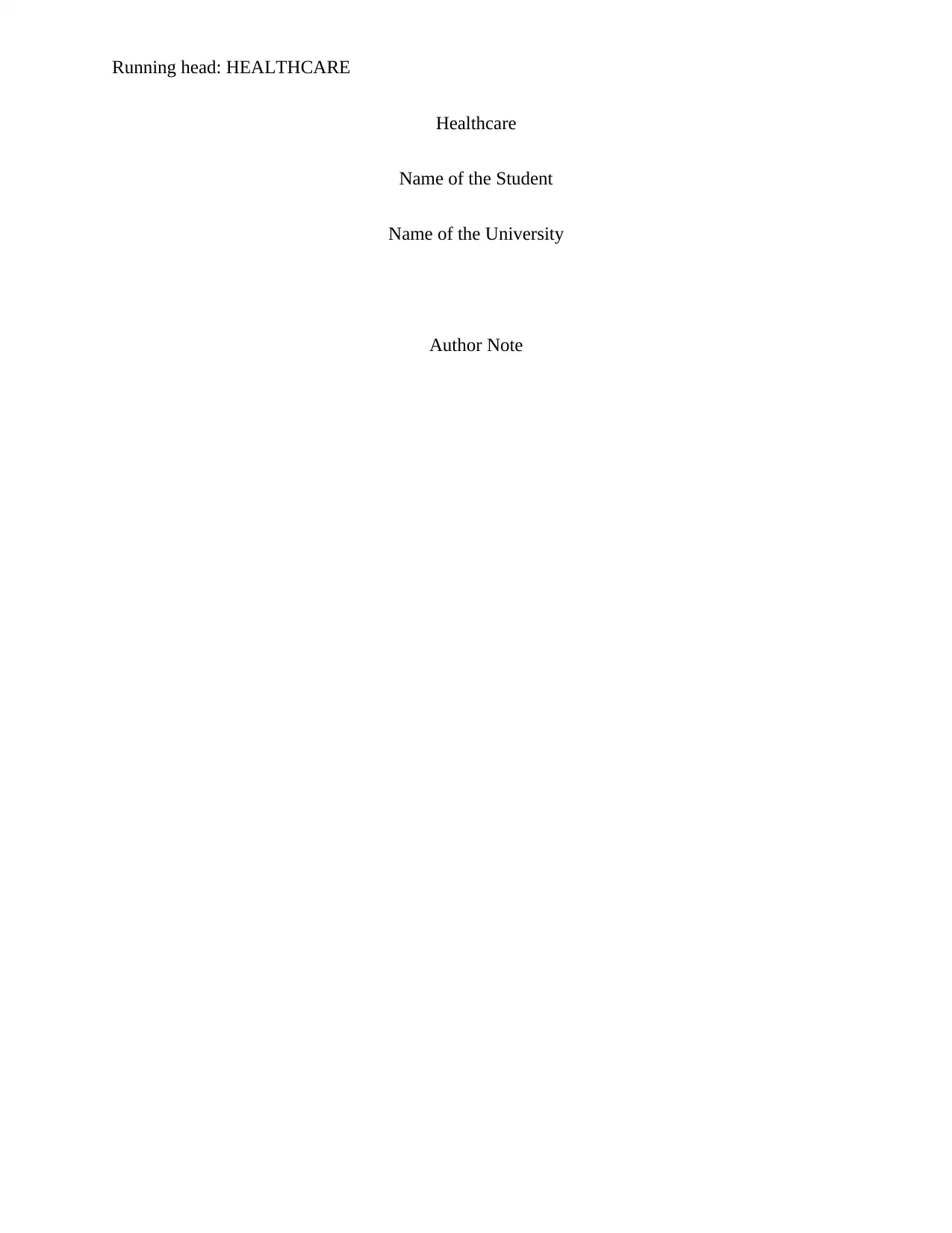
Running head: HEALTHCARE
Healthcare
Name of the Student
Name of the University
Author Note
Healthcare
Name of the Student
Name of the University
Author Note
Paraphrase This Document
Need a fresh take? Get an instant paraphrase of this document with our AI Paraphraser
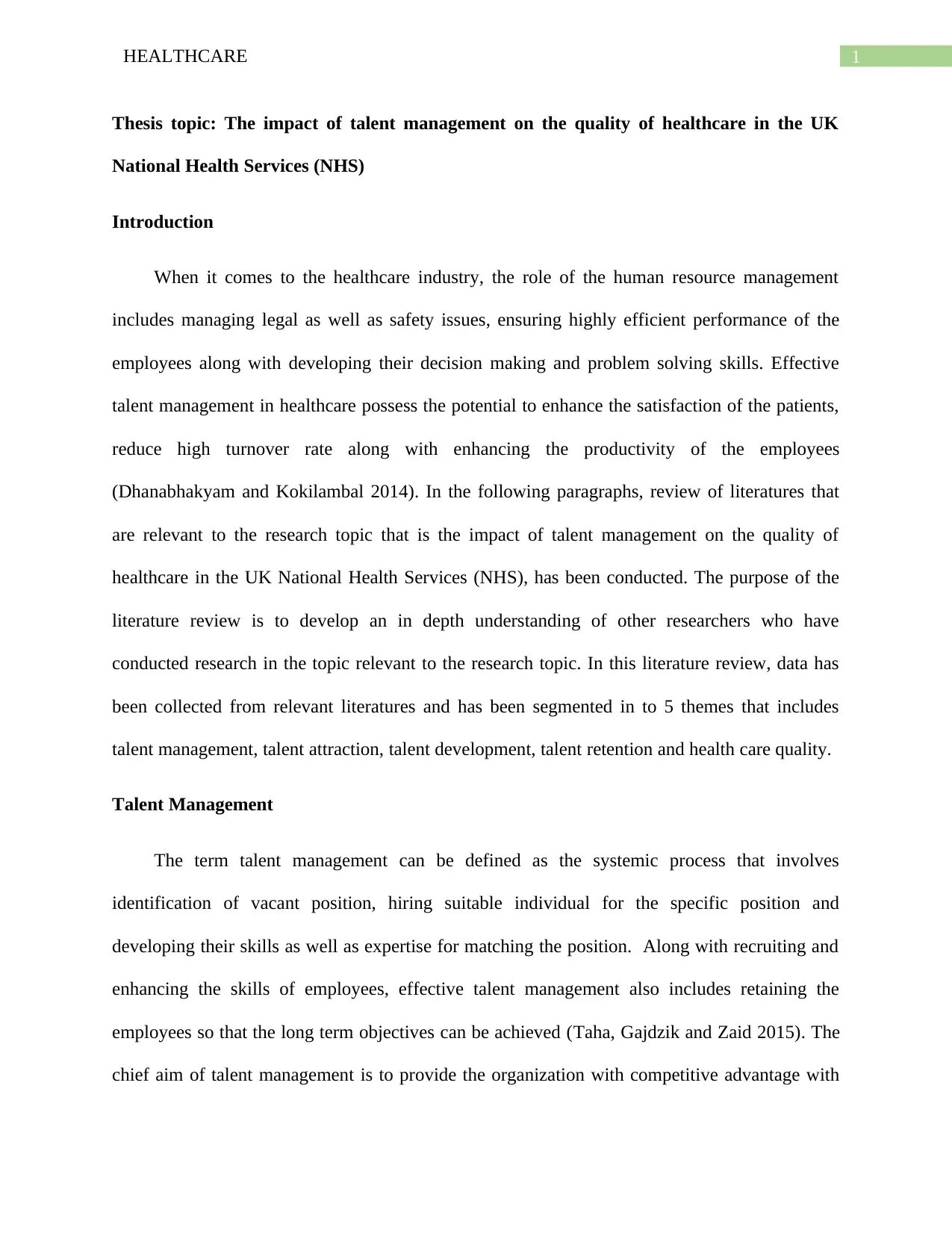
1HEALTHCARE
Thesis topic: The impact of talent management on the quality of healthcare in the UK
National Health Services (NHS)
Introduction
When it comes to the healthcare industry, the role of the human resource management
includes managing legal as well as safety issues, ensuring highly efficient performance of the
employees along with developing their decision making and problem solving skills. Effective
talent management in healthcare possess the potential to enhance the satisfaction of the patients,
reduce high turnover rate along with enhancing the productivity of the employees
(Dhanabhakyam and Kokilambal 2014). In the following paragraphs, review of literatures that
are relevant to the research topic that is the impact of talent management on the quality of
healthcare in the UK National Health Services (NHS), has been conducted. The purpose of the
literature review is to develop an in depth understanding of other researchers who have
conducted research in the topic relevant to the research topic. In this literature review, data has
been collected from relevant literatures and has been segmented in to 5 themes that includes
talent management, talent attraction, talent development, talent retention and health care quality.
Talent Management
The term talent management can be defined as the systemic process that involves
identification of vacant position, hiring suitable individual for the specific position and
developing their skills as well as expertise for matching the position. Along with recruiting and
enhancing the skills of employees, effective talent management also includes retaining the
employees so that the long term objectives can be achieved (Taha, Gajdzik and Zaid 2015). The
chief aim of talent management is to provide the organization with competitive advantage with
Thesis topic: The impact of talent management on the quality of healthcare in the UK
National Health Services (NHS)
Introduction
When it comes to the healthcare industry, the role of the human resource management
includes managing legal as well as safety issues, ensuring highly efficient performance of the
employees along with developing their decision making and problem solving skills. Effective
talent management in healthcare possess the potential to enhance the satisfaction of the patients,
reduce high turnover rate along with enhancing the productivity of the employees
(Dhanabhakyam and Kokilambal 2014). In the following paragraphs, review of literatures that
are relevant to the research topic that is the impact of talent management on the quality of
healthcare in the UK National Health Services (NHS), has been conducted. The purpose of the
literature review is to develop an in depth understanding of other researchers who have
conducted research in the topic relevant to the research topic. In this literature review, data has
been collected from relevant literatures and has been segmented in to 5 themes that includes
talent management, talent attraction, talent development, talent retention and health care quality.
Talent Management
The term talent management can be defined as the systemic process that involves
identification of vacant position, hiring suitable individual for the specific position and
developing their skills as well as expertise for matching the position. Along with recruiting and
enhancing the skills of employees, effective talent management also includes retaining the
employees so that the long term objectives can be achieved (Taha, Gajdzik and Zaid 2015). The
chief aim of talent management is to provide the organization with competitive advantage with
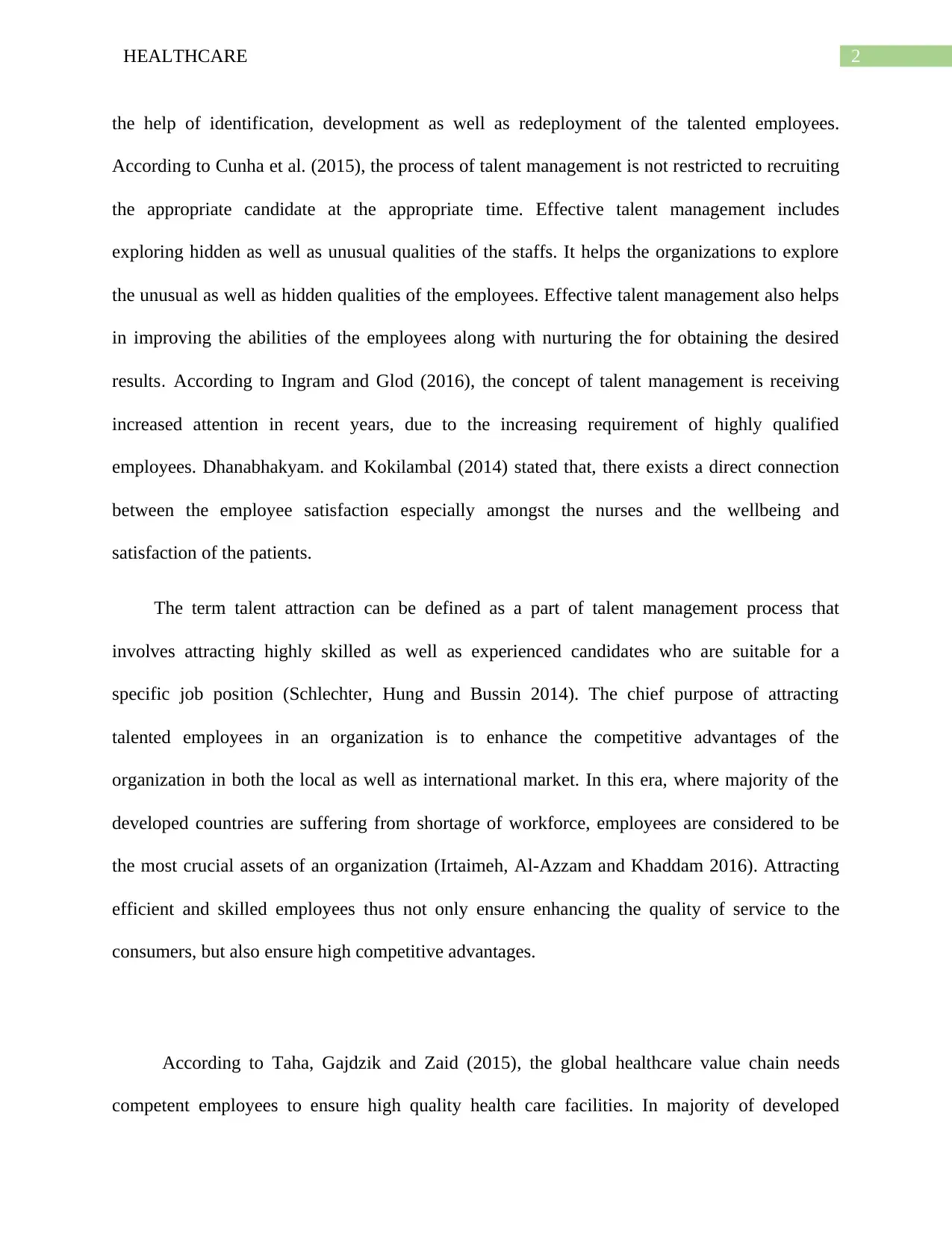
2HEALTHCARE
the help of identification, development as well as redeployment of the talented employees.
According to Cunha et al. (2015), the process of talent management is not restricted to recruiting
the appropriate candidate at the appropriate time. Effective talent management includes
exploring hidden as well as unusual qualities of the staffs. It helps the organizations to explore
the unusual as well as hidden qualities of the employees. Effective talent management also helps
in improving the abilities of the employees along with nurturing the for obtaining the desired
results. According to Ingram and Glod (2016), the concept of talent management is receiving
increased attention in recent years, due to the increasing requirement of highly qualified
employees. Dhanabhakyam. and Kokilambal (2014) stated that, there exists a direct connection
between the employee satisfaction especially amongst the nurses and the wellbeing and
satisfaction of the patients.
The term talent attraction can be defined as a part of talent management process that
involves attracting highly skilled as well as experienced candidates who are suitable for a
specific job position (Schlechter, Hung and Bussin 2014). The chief purpose of attracting
talented employees in an organization is to enhance the competitive advantages of the
organization in both the local as well as international market. In this era, where majority of the
developed countries are suffering from shortage of workforce, employees are considered to be
the most crucial assets of an organization (Irtaimeh, Al-Azzam and Khaddam 2016). Attracting
efficient and skilled employees thus not only ensure enhancing the quality of service to the
consumers, but also ensure high competitive advantages.
According to Taha, Gajdzik and Zaid (2015), the global healthcare value chain needs
competent employees to ensure high quality health care facilities. In majority of developed
the help of identification, development as well as redeployment of the talented employees.
According to Cunha et al. (2015), the process of talent management is not restricted to recruiting
the appropriate candidate at the appropriate time. Effective talent management includes
exploring hidden as well as unusual qualities of the staffs. It helps the organizations to explore
the unusual as well as hidden qualities of the employees. Effective talent management also helps
in improving the abilities of the employees along with nurturing the for obtaining the desired
results. According to Ingram and Glod (2016), the concept of talent management is receiving
increased attention in recent years, due to the increasing requirement of highly qualified
employees. Dhanabhakyam. and Kokilambal (2014) stated that, there exists a direct connection
between the employee satisfaction especially amongst the nurses and the wellbeing and
satisfaction of the patients.
The term talent attraction can be defined as a part of talent management process that
involves attracting highly skilled as well as experienced candidates who are suitable for a
specific job position (Schlechter, Hung and Bussin 2014). The chief purpose of attracting
talented employees in an organization is to enhance the competitive advantages of the
organization in both the local as well as international market. In this era, where majority of the
developed countries are suffering from shortage of workforce, employees are considered to be
the most crucial assets of an organization (Irtaimeh, Al-Azzam and Khaddam 2016). Attracting
efficient and skilled employees thus not only ensure enhancing the quality of service to the
consumers, but also ensure high competitive advantages.
According to Taha, Gajdzik and Zaid (2015), the global healthcare value chain needs
competent employees to ensure high quality health care facilities. In majority of developed
⊘ This is a preview!⊘
Do you want full access?
Subscribe today to unlock all pages.

Trusted by 1+ million students worldwide
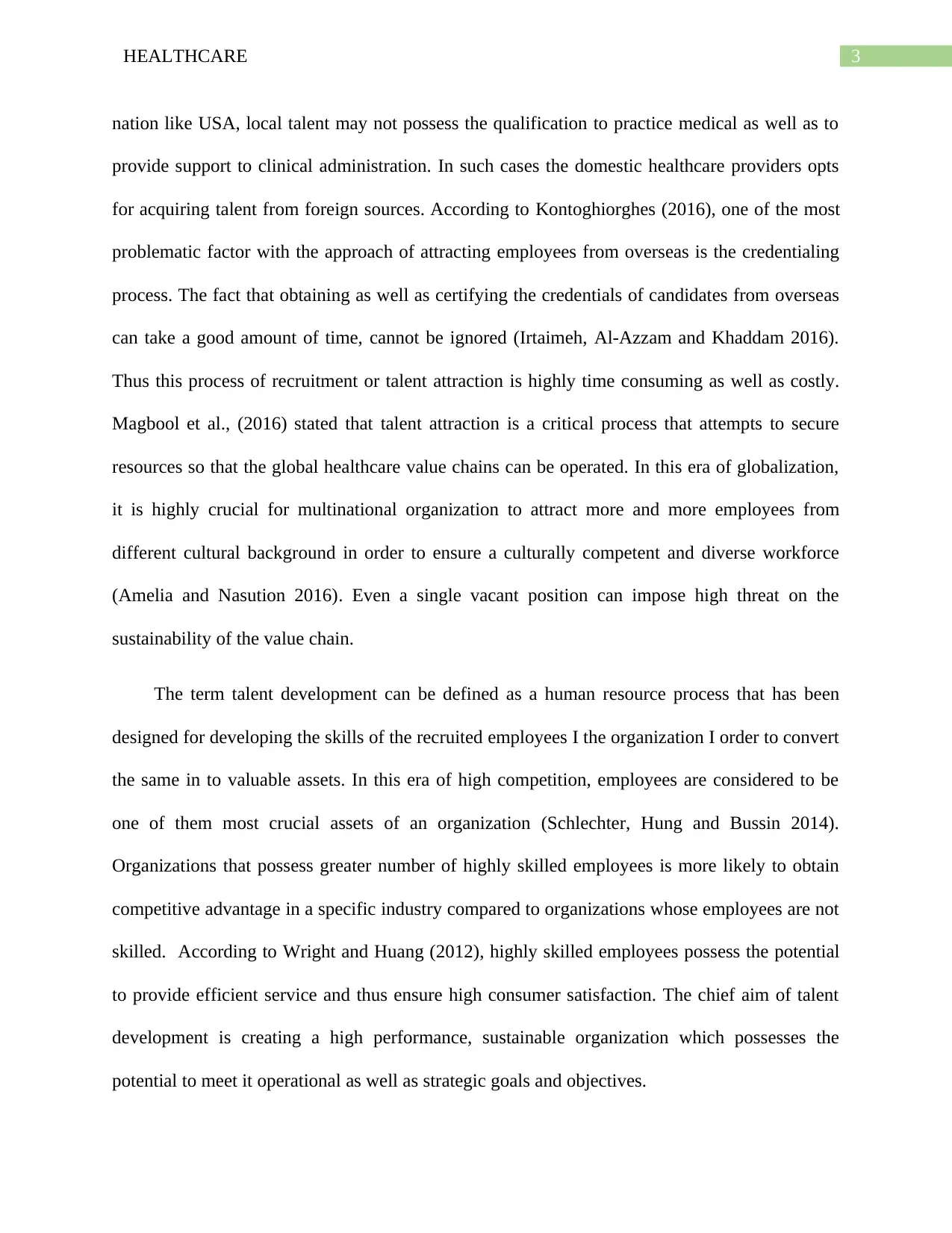
3HEALTHCARE
nation like USA, local talent may not possess the qualification to practice medical as well as to
provide support to clinical administration. In such cases the domestic healthcare providers opts
for acquiring talent from foreign sources. According to Kontoghiorghes (2016), one of the most
problematic factor with the approach of attracting employees from overseas is the credentialing
process. The fact that obtaining as well as certifying the credentials of candidates from overseas
can take a good amount of time, cannot be ignored (Irtaimeh, Al-Azzam and Khaddam 2016).
Thus this process of recruitment or talent attraction is highly time consuming as well as costly.
Magbool et al., (2016) stated that talent attraction is a critical process that attempts to secure
resources so that the global healthcare value chains can be operated. In this era of globalization,
it is highly crucial for multinational organization to attract more and more employees from
different cultural background in order to ensure a culturally competent and diverse workforce
(Amelia and Nasution 2016). Even a single vacant position can impose high threat on the
sustainability of the value chain.
The term talent development can be defined as a human resource process that has been
designed for developing the skills of the recruited employees I the organization I order to convert
the same in to valuable assets. In this era of high competition, employees are considered to be
one of them most crucial assets of an organization (Schlechter, Hung and Bussin 2014).
Organizations that possess greater number of highly skilled employees is more likely to obtain
competitive advantage in a specific industry compared to organizations whose employees are not
skilled. According to Wright and Huang (2012), highly skilled employees possess the potential
to provide efficient service and thus ensure high consumer satisfaction. The chief aim of talent
development is creating a high performance, sustainable organization which possesses the
potential to meet it operational as well as strategic goals and objectives.
nation like USA, local talent may not possess the qualification to practice medical as well as to
provide support to clinical administration. In such cases the domestic healthcare providers opts
for acquiring talent from foreign sources. According to Kontoghiorghes (2016), one of the most
problematic factor with the approach of attracting employees from overseas is the credentialing
process. The fact that obtaining as well as certifying the credentials of candidates from overseas
can take a good amount of time, cannot be ignored (Irtaimeh, Al-Azzam and Khaddam 2016).
Thus this process of recruitment or talent attraction is highly time consuming as well as costly.
Magbool et al., (2016) stated that talent attraction is a critical process that attempts to secure
resources so that the global healthcare value chains can be operated. In this era of globalization,
it is highly crucial for multinational organization to attract more and more employees from
different cultural background in order to ensure a culturally competent and diverse workforce
(Amelia and Nasution 2016). Even a single vacant position can impose high threat on the
sustainability of the value chain.
The term talent development can be defined as a human resource process that has been
designed for developing the skills of the recruited employees I the organization I order to convert
the same in to valuable assets. In this era of high competition, employees are considered to be
one of them most crucial assets of an organization (Schlechter, Hung and Bussin 2014).
Organizations that possess greater number of highly skilled employees is more likely to obtain
competitive advantage in a specific industry compared to organizations whose employees are not
skilled. According to Wright and Huang (2012), highly skilled employees possess the potential
to provide efficient service and thus ensure high consumer satisfaction. The chief aim of talent
development is creating a high performance, sustainable organization which possesses the
potential to meet it operational as well as strategic goals and objectives.
Paraphrase This Document
Need a fresh take? Get an instant paraphrase of this document with our AI Paraphraser
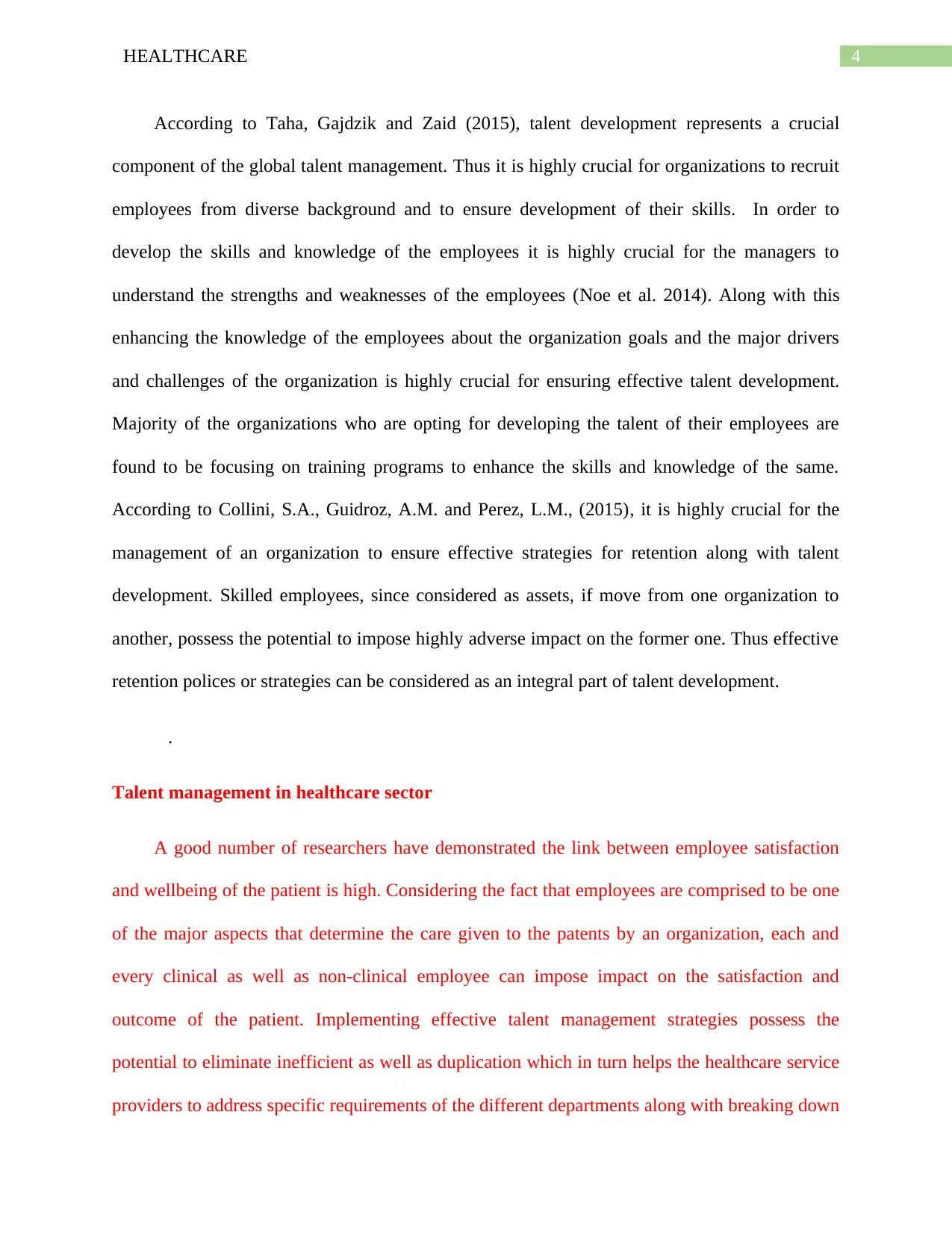
4HEALTHCARE
According to Taha, Gajdzik and Zaid (2015), talent development represents a crucial
component of the global talent management. Thus it is highly crucial for organizations to recruit
employees from diverse background and to ensure development of their skills. In order to
develop the skills and knowledge of the employees it is highly crucial for the managers to
understand the strengths and weaknesses of the employees (Noe et al. 2014). Along with this
enhancing the knowledge of the employees about the organization goals and the major drivers
and challenges of the organization is highly crucial for ensuring effective talent development.
Majority of the organizations who are opting for developing the talent of their employees are
found to be focusing on training programs to enhance the skills and knowledge of the same.
According to Collini, S.A., Guidroz, A.M. and Perez, L.M., (2015), it is highly crucial for the
management of an organization to ensure effective strategies for retention along with talent
development. Skilled employees, since considered as assets, if move from one organization to
another, possess the potential to impose highly adverse impact on the former one. Thus effective
retention polices or strategies can be considered as an integral part of talent development.
.
Talent management in healthcare sector
A good number of researchers have demonstrated the link between employee satisfaction
and wellbeing of the patient is high. Considering the fact that employees are comprised to be one
of the major aspects that determine the care given to the patents by an organization, each and
every clinical as well as non-clinical employee can impose impact on the satisfaction and
outcome of the patient. Implementing effective talent management strategies possess the
potential to eliminate inefficient as well as duplication which in turn helps the healthcare service
providers to address specific requirements of the different departments along with breaking down
According to Taha, Gajdzik and Zaid (2015), talent development represents a crucial
component of the global talent management. Thus it is highly crucial for organizations to recruit
employees from diverse background and to ensure development of their skills. In order to
develop the skills and knowledge of the employees it is highly crucial for the managers to
understand the strengths and weaknesses of the employees (Noe et al. 2014). Along with this
enhancing the knowledge of the employees about the organization goals and the major drivers
and challenges of the organization is highly crucial for ensuring effective talent development.
Majority of the organizations who are opting for developing the talent of their employees are
found to be focusing on training programs to enhance the skills and knowledge of the same.
According to Collini, S.A., Guidroz, A.M. and Perez, L.M., (2015), it is highly crucial for the
management of an organization to ensure effective strategies for retention along with talent
development. Skilled employees, since considered as assets, if move from one organization to
another, possess the potential to impose highly adverse impact on the former one. Thus effective
retention polices or strategies can be considered as an integral part of talent development.
.
Talent management in healthcare sector
A good number of researchers have demonstrated the link between employee satisfaction
and wellbeing of the patient is high. Considering the fact that employees are comprised to be one
of the major aspects that determine the care given to the patents by an organization, each and
every clinical as well as non-clinical employee can impose impact on the satisfaction and
outcome of the patient. Implementing effective talent management strategies possess the
potential to eliminate inefficient as well as duplication which in turn helps the healthcare service
providers to address specific requirements of the different departments along with breaking down
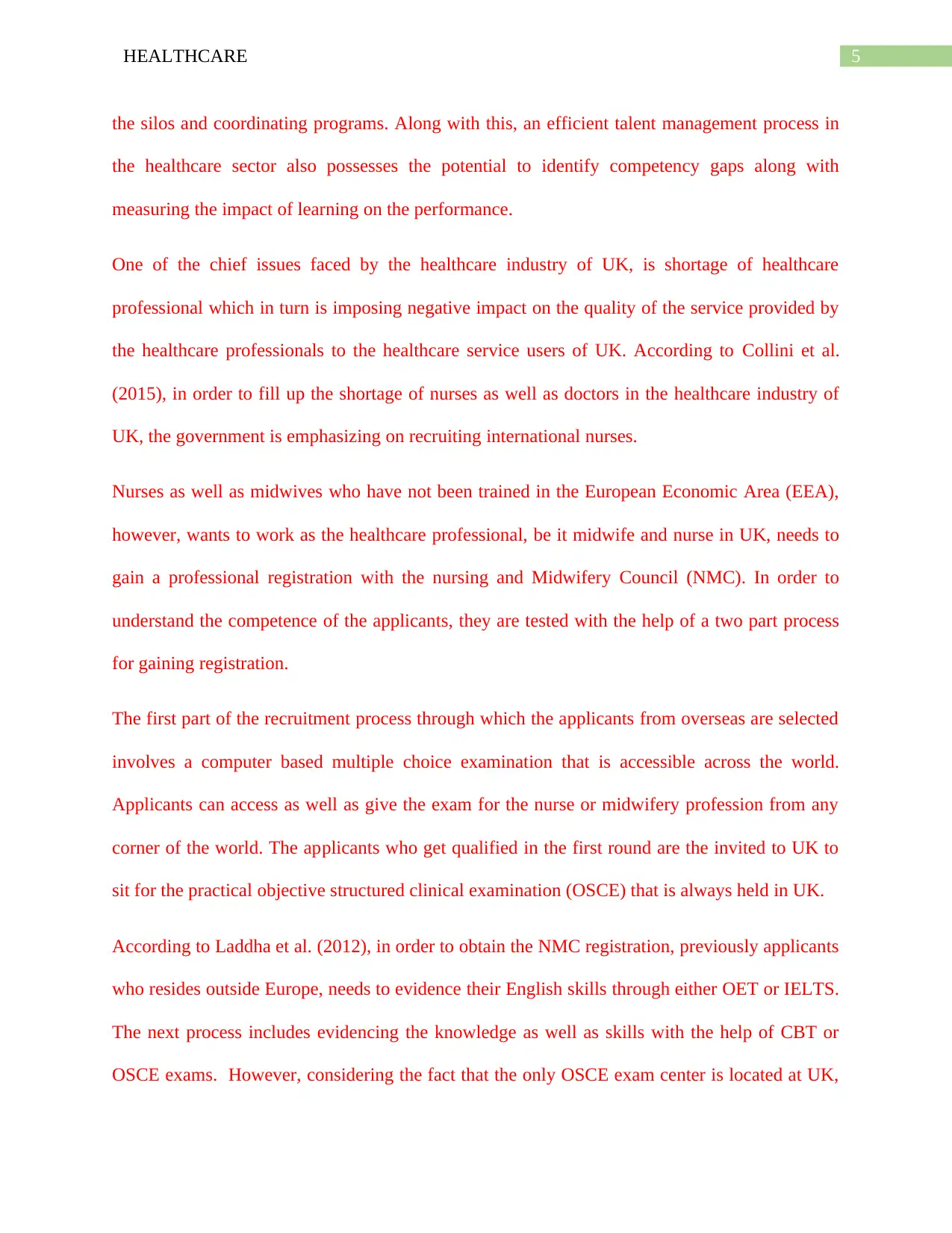
5HEALTHCARE
the silos and coordinating programs. Along with this, an efficient talent management process in
the healthcare sector also possesses the potential to identify competency gaps along with
measuring the impact of learning on the performance.
One of the chief issues faced by the healthcare industry of UK, is shortage of healthcare
professional which in turn is imposing negative impact on the quality of the service provided by
the healthcare professionals to the healthcare service users of UK. According to Collini et al.
(2015), in order to fill up the shortage of nurses as well as doctors in the healthcare industry of
UK, the government is emphasizing on recruiting international nurses.
Nurses as well as midwives who have not been trained in the European Economic Area (EEA),
however, wants to work as the healthcare professional, be it midwife and nurse in UK, needs to
gain a professional registration with the nursing and Midwifery Council (NMC). In order to
understand the competence of the applicants, they are tested with the help of a two part process
for gaining registration.
The first part of the recruitment process through which the applicants from overseas are selected
involves a computer based multiple choice examination that is accessible across the world.
Applicants can access as well as give the exam for the nurse or midwifery profession from any
corner of the world. The applicants who get qualified in the first round are the invited to UK to
sit for the practical objective structured clinical examination (OSCE) that is always held in UK.
According to Laddha et al. (2012), in order to obtain the NMC registration, previously applicants
who resides outside Europe, needs to evidence their English skills through either OET or IELTS.
The next process includes evidencing the knowledge as well as skills with the help of CBT or
OSCE exams. However, considering the fact that the only OSCE exam center is located at UK,
the silos and coordinating programs. Along with this, an efficient talent management process in
the healthcare sector also possesses the potential to identify competency gaps along with
measuring the impact of learning on the performance.
One of the chief issues faced by the healthcare industry of UK, is shortage of healthcare
professional which in turn is imposing negative impact on the quality of the service provided by
the healthcare professionals to the healthcare service users of UK. According to Collini et al.
(2015), in order to fill up the shortage of nurses as well as doctors in the healthcare industry of
UK, the government is emphasizing on recruiting international nurses.
Nurses as well as midwives who have not been trained in the European Economic Area (EEA),
however, wants to work as the healthcare professional, be it midwife and nurse in UK, needs to
gain a professional registration with the nursing and Midwifery Council (NMC). In order to
understand the competence of the applicants, they are tested with the help of a two part process
for gaining registration.
The first part of the recruitment process through which the applicants from overseas are selected
involves a computer based multiple choice examination that is accessible across the world.
Applicants can access as well as give the exam for the nurse or midwifery profession from any
corner of the world. The applicants who get qualified in the first round are the invited to UK to
sit for the practical objective structured clinical examination (OSCE) that is always held in UK.
According to Laddha et al. (2012), in order to obtain the NMC registration, previously applicants
who resides outside Europe, needs to evidence their English skills through either OET or IELTS.
The next process includes evidencing the knowledge as well as skills with the help of CBT or
OSCE exams. However, considering the fact that the only OSCE exam center is located at UK,
⊘ This is a preview!⊘
Do you want full access?
Subscribe today to unlock all pages.

Trusted by 1+ million students worldwide
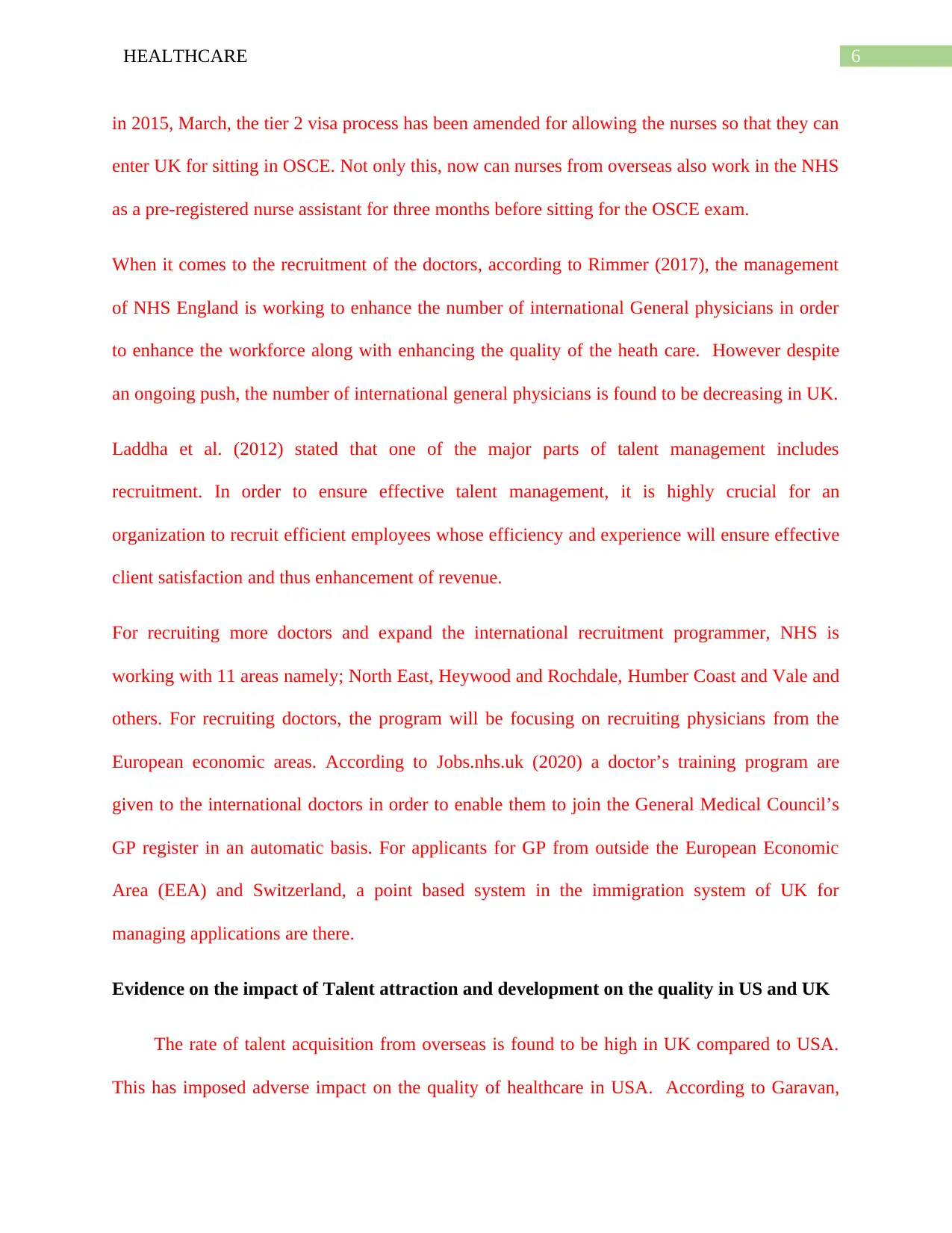
6HEALTHCARE
in 2015, March, the tier 2 visa process has been amended for allowing the nurses so that they can
enter UK for sitting in OSCE. Not only this, now can nurses from overseas also work in the NHS
as a pre-registered nurse assistant for three months before sitting for the OSCE exam.
When it comes to the recruitment of the doctors, according to Rimmer (2017), the management
of NHS England is working to enhance the number of international General physicians in order
to enhance the workforce along with enhancing the quality of the heath care. However despite
an ongoing push, the number of international general physicians is found to be decreasing in UK.
Laddha et al. (2012) stated that one of the major parts of talent management includes
recruitment. In order to ensure effective talent management, it is highly crucial for an
organization to recruit efficient employees whose efficiency and experience will ensure effective
client satisfaction and thus enhancement of revenue.
For recruiting more doctors and expand the international recruitment programmer, NHS is
working with 11 areas namely; North East, Heywood and Rochdale, Humber Coast and Vale and
others. For recruiting doctors, the program will be focusing on recruiting physicians from the
European economic areas. According to Jobs.nhs.uk (2020) a doctor’s training program are
given to the international doctors in order to enable them to join the General Medical Council’s
GP register in an automatic basis. For applicants for GP from outside the European Economic
Area (EEA) and Switzerland, a point based system in the immigration system of UK for
managing applications are there.
Evidence on the impact of Talent attraction and development on the quality in US and UK
The rate of talent acquisition from overseas is found to be high in UK compared to USA.
This has imposed adverse impact on the quality of healthcare in USA. According to Garavan,
in 2015, March, the tier 2 visa process has been amended for allowing the nurses so that they can
enter UK for sitting in OSCE. Not only this, now can nurses from overseas also work in the NHS
as a pre-registered nurse assistant for three months before sitting for the OSCE exam.
When it comes to the recruitment of the doctors, according to Rimmer (2017), the management
of NHS England is working to enhance the number of international General physicians in order
to enhance the workforce along with enhancing the quality of the heath care. However despite
an ongoing push, the number of international general physicians is found to be decreasing in UK.
Laddha et al. (2012) stated that one of the major parts of talent management includes
recruitment. In order to ensure effective talent management, it is highly crucial for an
organization to recruit efficient employees whose efficiency and experience will ensure effective
client satisfaction and thus enhancement of revenue.
For recruiting more doctors and expand the international recruitment programmer, NHS is
working with 11 areas namely; North East, Heywood and Rochdale, Humber Coast and Vale and
others. For recruiting doctors, the program will be focusing on recruiting physicians from the
European economic areas. According to Jobs.nhs.uk (2020) a doctor’s training program are
given to the international doctors in order to enable them to join the General Medical Council’s
GP register in an automatic basis. For applicants for GP from outside the European Economic
Area (EEA) and Switzerland, a point based system in the immigration system of UK for
managing applications are there.
Evidence on the impact of Talent attraction and development on the quality in US and UK
The rate of talent acquisition from overseas is found to be high in UK compared to USA.
This has imposed adverse impact on the quality of healthcare in USA. According to Garavan,
Paraphrase This Document
Need a fresh take? Get an instant paraphrase of this document with our AI Paraphraser
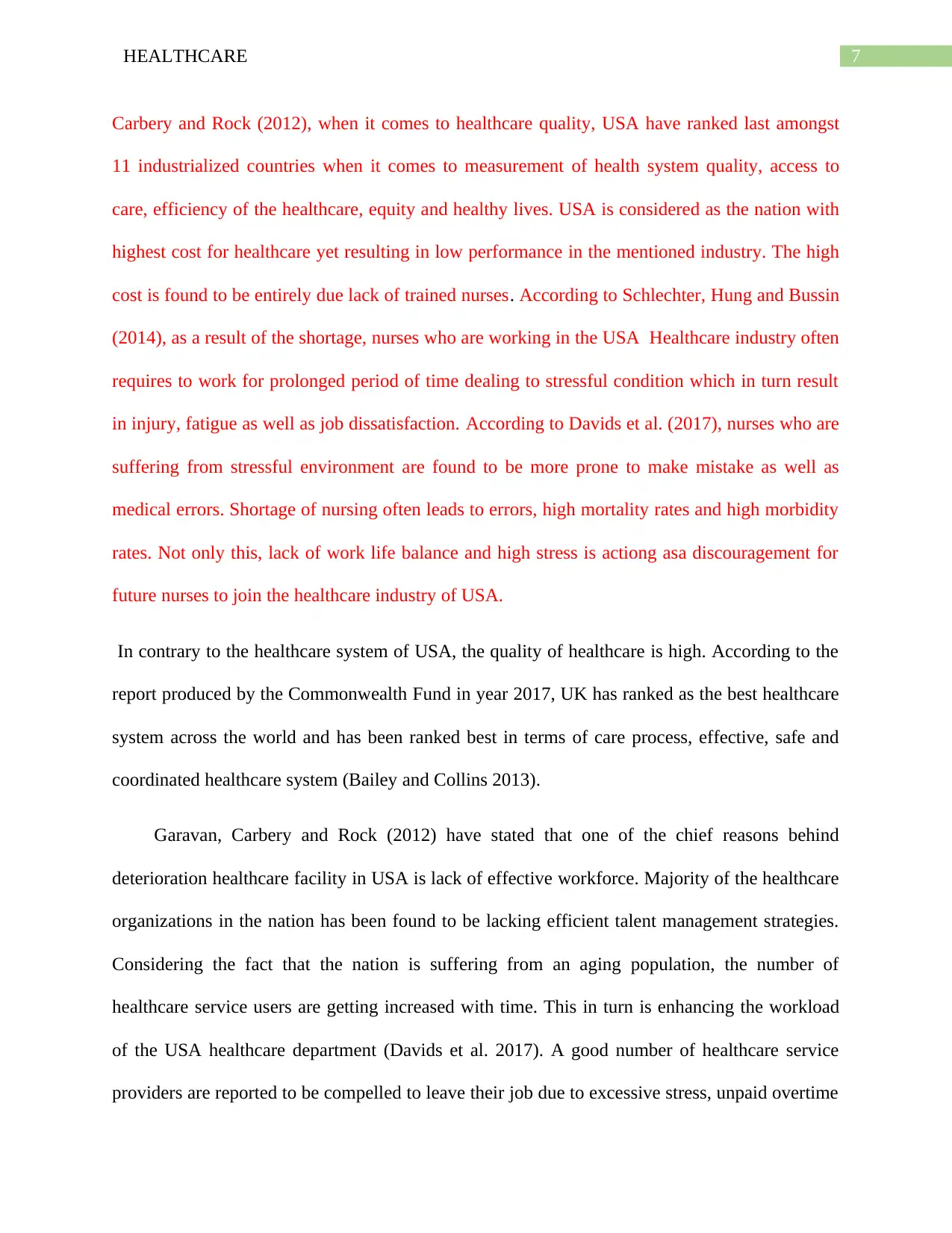
7HEALTHCARE
Carbery and Rock (2012), when it comes to healthcare quality, USA have ranked last amongst
11 industrialized countries when it comes to measurement of health system quality, access to
care, efficiency of the healthcare, equity and healthy lives. USA is considered as the nation with
highest cost for healthcare yet resulting in low performance in the mentioned industry. The high
cost is found to be entirely due lack of trained nurses. According to Schlechter, Hung and Bussin
(2014), as a result of the shortage, nurses who are working in the USA Healthcare industry often
requires to work for prolonged period of time dealing to stressful condition which in turn result
in injury, fatigue as well as job dissatisfaction. According to Davids et al. (2017), nurses who are
suffering from stressful environment are found to be more prone to make mistake as well as
medical errors. Shortage of nursing often leads to errors, high mortality rates and high morbidity
rates. Not only this, lack of work life balance and high stress is actiong asa discouragement for
future nurses to join the healthcare industry of USA.
In contrary to the healthcare system of USA, the quality of healthcare is high. According to the
report produced by the Commonwealth Fund in year 2017, UK has ranked as the best healthcare
system across the world and has been ranked best in terms of care process, effective, safe and
coordinated healthcare system (Bailey and Collins 2013).
Garavan, Carbery and Rock (2012) have stated that one of the chief reasons behind
deterioration healthcare facility in USA is lack of effective workforce. Majority of the healthcare
organizations in the nation has been found to be lacking efficient talent management strategies.
Considering the fact that the nation is suffering from an aging population, the number of
healthcare service users are getting increased with time. This in turn is enhancing the workload
of the USA healthcare department (Davids et al. 2017). A good number of healthcare service
providers are reported to be compelled to leave their job due to excessive stress, unpaid overtime
Carbery and Rock (2012), when it comes to healthcare quality, USA have ranked last amongst
11 industrialized countries when it comes to measurement of health system quality, access to
care, efficiency of the healthcare, equity and healthy lives. USA is considered as the nation with
highest cost for healthcare yet resulting in low performance in the mentioned industry. The high
cost is found to be entirely due lack of trained nurses. According to Schlechter, Hung and Bussin
(2014), as a result of the shortage, nurses who are working in the USA Healthcare industry often
requires to work for prolonged period of time dealing to stressful condition which in turn result
in injury, fatigue as well as job dissatisfaction. According to Davids et al. (2017), nurses who are
suffering from stressful environment are found to be more prone to make mistake as well as
medical errors. Shortage of nursing often leads to errors, high mortality rates and high morbidity
rates. Not only this, lack of work life balance and high stress is actiong asa discouragement for
future nurses to join the healthcare industry of USA.
In contrary to the healthcare system of USA, the quality of healthcare is high. According to the
report produced by the Commonwealth Fund in year 2017, UK has ranked as the best healthcare
system across the world and has been ranked best in terms of care process, effective, safe and
coordinated healthcare system (Bailey and Collins 2013).
Garavan, Carbery and Rock (2012) have stated that one of the chief reasons behind
deterioration healthcare facility in USA is lack of effective workforce. Majority of the healthcare
organizations in the nation has been found to be lacking efficient talent management strategies.
Considering the fact that the nation is suffering from an aging population, the number of
healthcare service users are getting increased with time. This in turn is enhancing the workload
of the USA healthcare department (Davids et al. 2017). A good number of healthcare service
providers are reported to be compelled to leave their job due to excessive stress, unpaid overtime
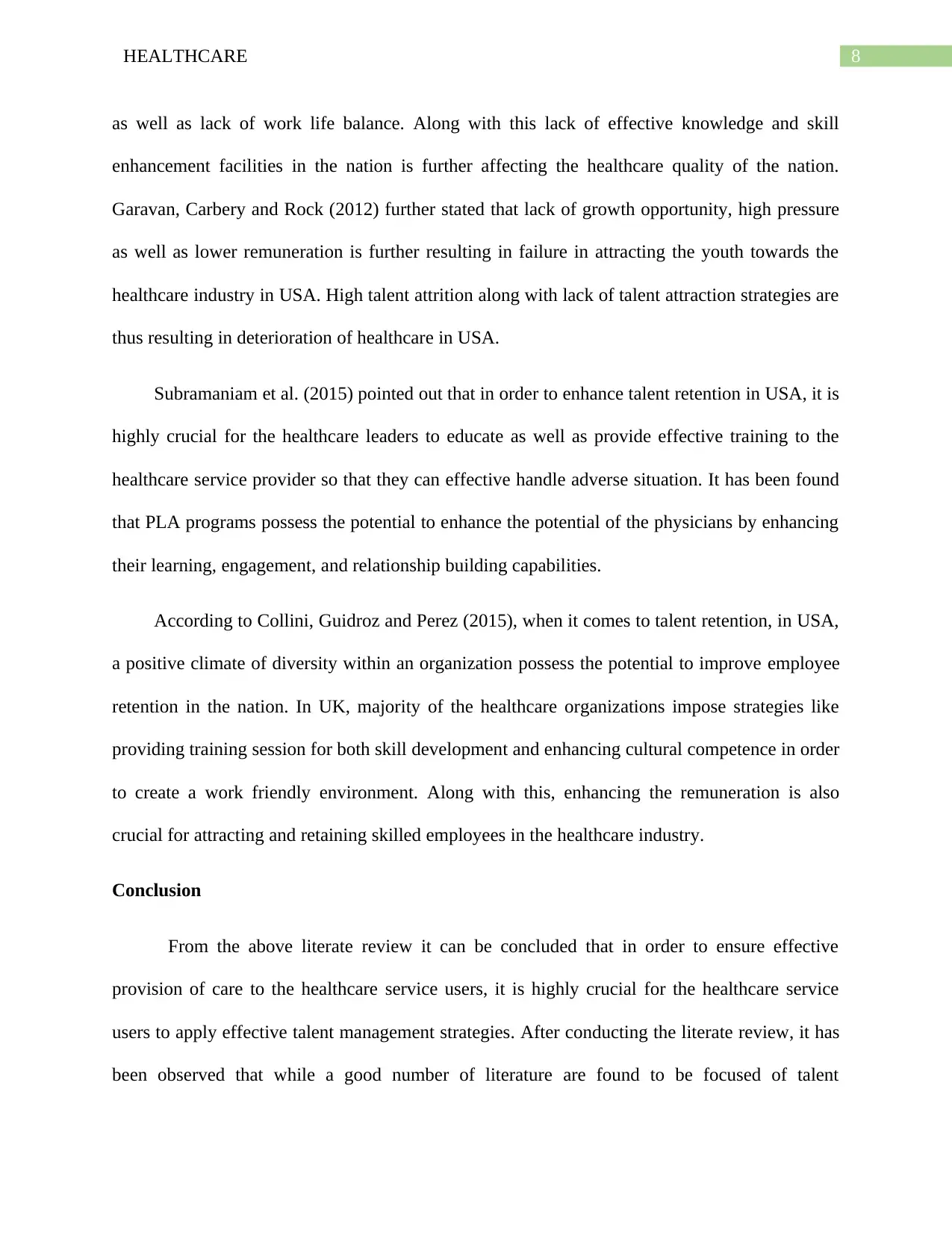
8HEALTHCARE
as well as lack of work life balance. Along with this lack of effective knowledge and skill
enhancement facilities in the nation is further affecting the healthcare quality of the nation.
Garavan, Carbery and Rock (2012) further stated that lack of growth opportunity, high pressure
as well as lower remuneration is further resulting in failure in attracting the youth towards the
healthcare industry in USA. High talent attrition along with lack of talent attraction strategies are
thus resulting in deterioration of healthcare in USA.
Subramaniam et al. (2015) pointed out that in order to enhance talent retention in USA, it is
highly crucial for the healthcare leaders to educate as well as provide effective training to the
healthcare service provider so that they can effective handle adverse situation. It has been found
that PLA programs possess the potential to enhance the potential of the physicians by enhancing
their learning, engagement, and relationship building capabilities.
According to Collini, Guidroz and Perez (2015), when it comes to talent retention, in USA,
a positive climate of diversity within an organization possess the potential to improve employee
retention in the nation. In UK, majority of the healthcare organizations impose strategies like
providing training session for both skill development and enhancing cultural competence in order
to create a work friendly environment. Along with this, enhancing the remuneration is also
crucial for attracting and retaining skilled employees in the healthcare industry.
Conclusion
From the above literate review it can be concluded that in order to ensure effective
provision of care to the healthcare service users, it is highly crucial for the healthcare service
users to apply effective talent management strategies. After conducting the literate review, it has
been observed that while a good number of literature are found to be focused of talent
as well as lack of work life balance. Along with this lack of effective knowledge and skill
enhancement facilities in the nation is further affecting the healthcare quality of the nation.
Garavan, Carbery and Rock (2012) further stated that lack of growth opportunity, high pressure
as well as lower remuneration is further resulting in failure in attracting the youth towards the
healthcare industry in USA. High talent attrition along with lack of talent attraction strategies are
thus resulting in deterioration of healthcare in USA.
Subramaniam et al. (2015) pointed out that in order to enhance talent retention in USA, it is
highly crucial for the healthcare leaders to educate as well as provide effective training to the
healthcare service provider so that they can effective handle adverse situation. It has been found
that PLA programs possess the potential to enhance the potential of the physicians by enhancing
their learning, engagement, and relationship building capabilities.
According to Collini, Guidroz and Perez (2015), when it comes to talent retention, in USA,
a positive climate of diversity within an organization possess the potential to improve employee
retention in the nation. In UK, majority of the healthcare organizations impose strategies like
providing training session for both skill development and enhancing cultural competence in order
to create a work friendly environment. Along with this, enhancing the remuneration is also
crucial for attracting and retaining skilled employees in the healthcare industry.
Conclusion
From the above literate review it can be concluded that in order to ensure effective
provision of care to the healthcare service users, it is highly crucial for the healthcare service
users to apply effective talent management strategies. After conducting the literate review, it has
been observed that while a good number of literature are found to be focused of talent
⊘ This is a preview!⊘
Do you want full access?
Subscribe today to unlock all pages.

Trusted by 1+ million students worldwide
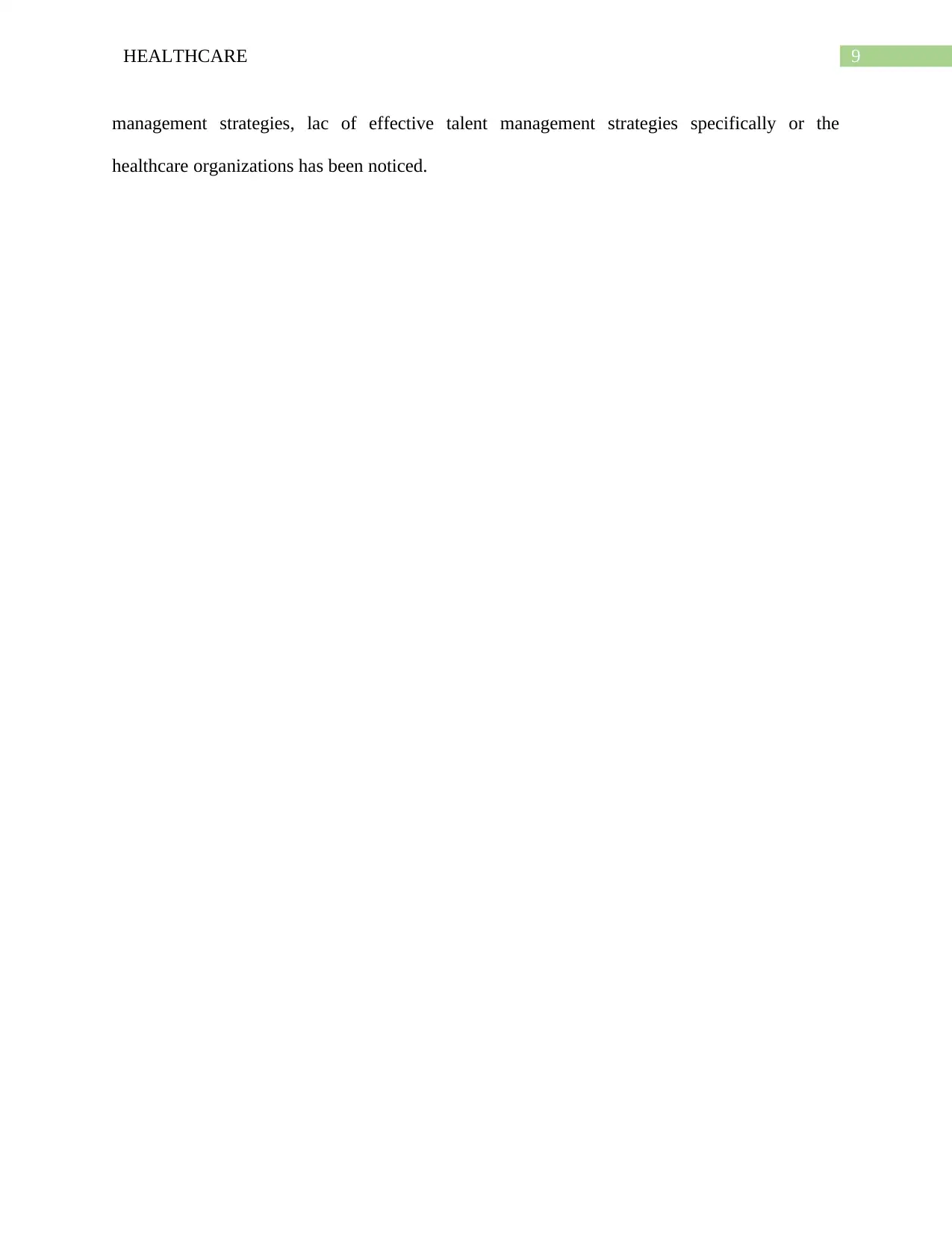
9HEALTHCARE
management strategies, lac of effective talent management strategies specifically or the
healthcare organizations has been noticed.
management strategies, lac of effective talent management strategies specifically or the
healthcare organizations has been noticed.
Paraphrase This Document
Need a fresh take? Get an instant paraphrase of this document with our AI Paraphraser
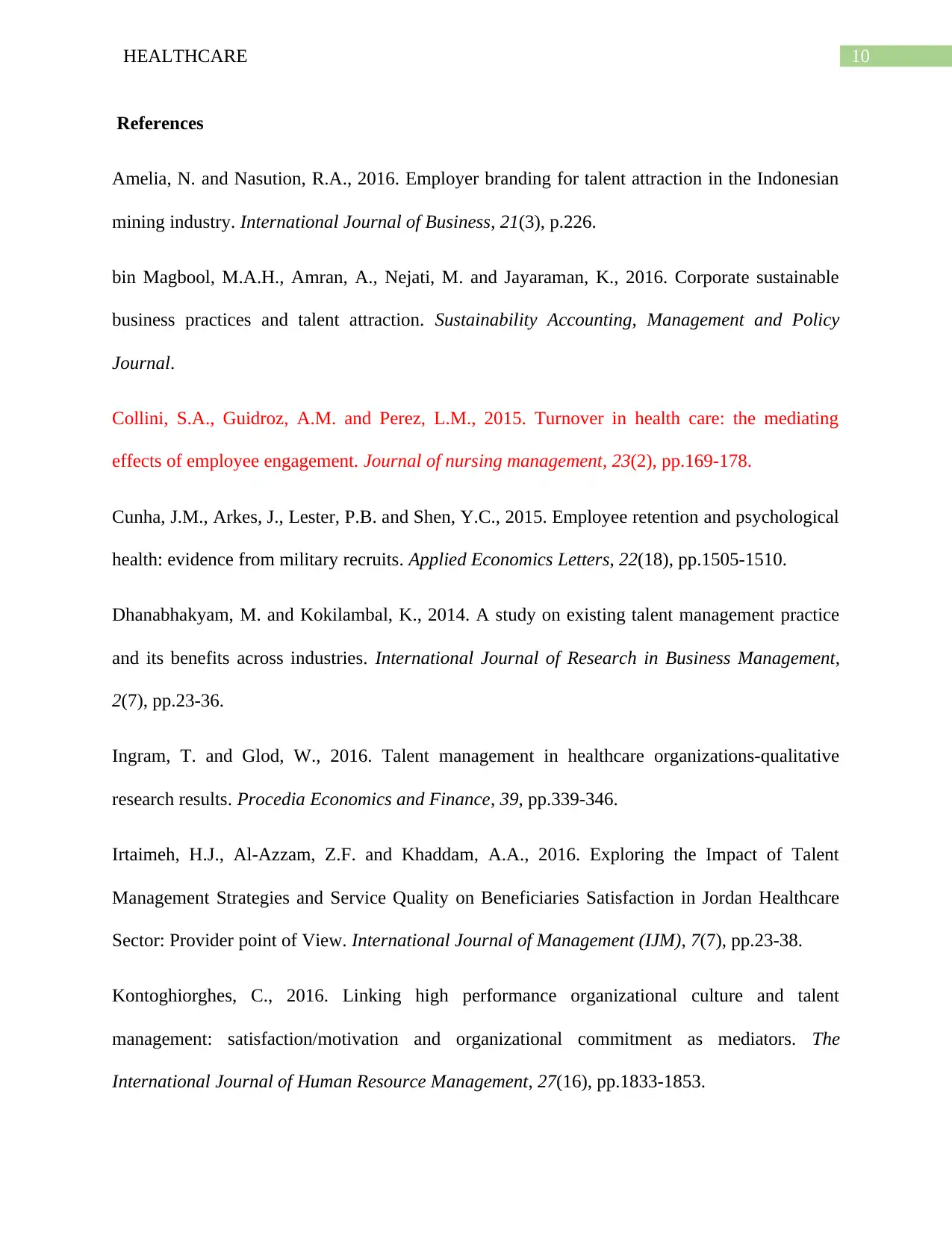
10HEALTHCARE
References
Amelia, N. and Nasution, R.A., 2016. Employer branding for talent attraction in the Indonesian
mining industry. International Journal of Business, 21(3), p.226.
bin Magbool, M.A.H., Amran, A., Nejati, M. and Jayaraman, K., 2016. Corporate sustainable
business practices and talent attraction. Sustainability Accounting, Management and Policy
Journal.
Collini, S.A., Guidroz, A.M. and Perez, L.M., 2015. Turnover in health care: the mediating
effects of employee engagement. Journal of nursing management, 23(2), pp.169-178.
Cunha, J.M., Arkes, J., Lester, P.B. and Shen, Y.C., 2015. Employee retention and psychological
health: evidence from military recruits. Applied Economics Letters, 22(18), pp.1505-1510.
Dhanabhakyam, M. and Kokilambal, K., 2014. A study on existing talent management practice
and its benefits across industries. International Journal of Research in Business Management,
2(7), pp.23-36.
Ingram, T. and Glod, W., 2016. Talent management in healthcare organizations-qualitative
research results. Procedia Economics and Finance, 39, pp.339-346.
Irtaimeh, H.J., Al-Azzam, Z.F. and Khaddam, A.A., 2016. Exploring the Impact of Talent
Management Strategies and Service Quality on Beneficiaries Satisfaction in Jordan Healthcare
Sector: Provider point of View. International Journal of Management (IJM), 7(7), pp.23-38.
Kontoghiorghes, C., 2016. Linking high performance organizational culture and talent
management: satisfaction/motivation and organizational commitment as mediators. The
International Journal of Human Resource Management, 27(16), pp.1833-1853.
References
Amelia, N. and Nasution, R.A., 2016. Employer branding for talent attraction in the Indonesian
mining industry. International Journal of Business, 21(3), p.226.
bin Magbool, M.A.H., Amran, A., Nejati, M. and Jayaraman, K., 2016. Corporate sustainable
business practices and talent attraction. Sustainability Accounting, Management and Policy
Journal.
Collini, S.A., Guidroz, A.M. and Perez, L.M., 2015. Turnover in health care: the mediating
effects of employee engagement. Journal of nursing management, 23(2), pp.169-178.
Cunha, J.M., Arkes, J., Lester, P.B. and Shen, Y.C., 2015. Employee retention and psychological
health: evidence from military recruits. Applied Economics Letters, 22(18), pp.1505-1510.
Dhanabhakyam, M. and Kokilambal, K., 2014. A study on existing talent management practice
and its benefits across industries. International Journal of Research in Business Management,
2(7), pp.23-36.
Ingram, T. and Glod, W., 2016. Talent management in healthcare organizations-qualitative
research results. Procedia Economics and Finance, 39, pp.339-346.
Irtaimeh, H.J., Al-Azzam, Z.F. and Khaddam, A.A., 2016. Exploring the Impact of Talent
Management Strategies and Service Quality on Beneficiaries Satisfaction in Jordan Healthcare
Sector: Provider point of View. International Journal of Management (IJM), 7(7), pp.23-38.
Kontoghiorghes, C., 2016. Linking high performance organizational culture and talent
management: satisfaction/motivation and organizational commitment as mediators. The
International Journal of Human Resource Management, 27(16), pp.1833-1853.
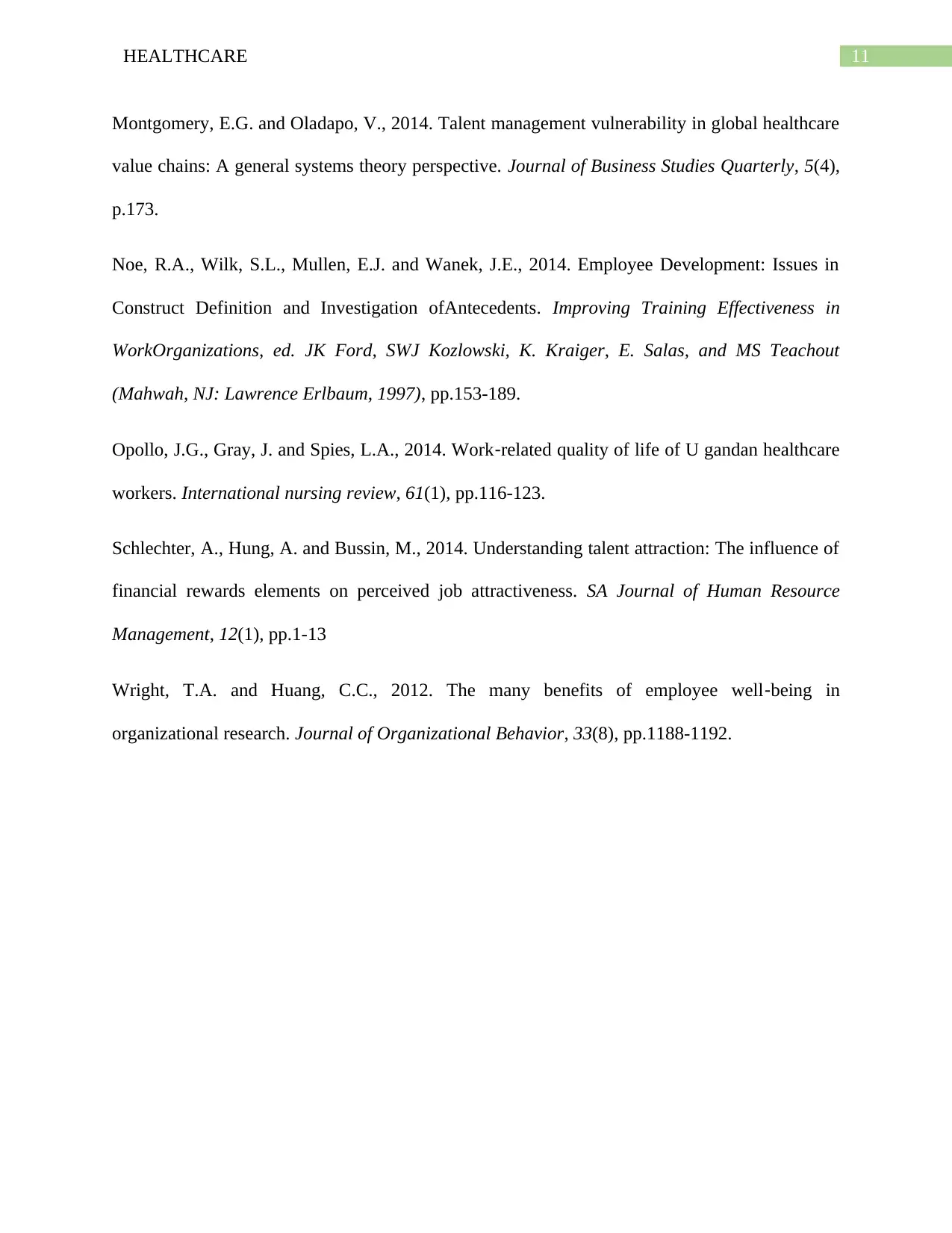
11HEALTHCARE
Montgomery, E.G. and Oladapo, V., 2014. Talent management vulnerability in global healthcare
value chains: A general systems theory perspective. Journal of Business Studies Quarterly, 5(4),
p.173.
Noe, R.A., Wilk, S.L., Mullen, E.J. and Wanek, J.E., 2014. Employee Development: Issues in
Construct Definition and Investigation ofAntecedents. Improving Training Effectiveness in
WorkOrganizations, ed. JK Ford, SWJ Kozlowski, K. Kraiger, E. Salas, and MS Teachout
(Mahwah, NJ: Lawrence Erlbaum, 1997), pp.153-189.
Opollo, J.G., Gray, J. and Spies, L.A., 2014. Work‐related quality of life of U gandan healthcare
workers. International nursing review, 61(1), pp.116-123.
Schlechter, A., Hung, A. and Bussin, M., 2014. Understanding talent attraction: The influence of
financial rewards elements on perceived job attractiveness. SA Journal of Human Resource
Management, 12(1), pp.1-13
Wright, T.A. and Huang, C.C., 2012. The many benefits of employee well‐being in
organizational research. Journal of Organizational Behavior, 33(8), pp.1188-1192.
Montgomery, E.G. and Oladapo, V., 2014. Talent management vulnerability in global healthcare
value chains: A general systems theory perspective. Journal of Business Studies Quarterly, 5(4),
p.173.
Noe, R.A., Wilk, S.L., Mullen, E.J. and Wanek, J.E., 2014. Employee Development: Issues in
Construct Definition and Investigation ofAntecedents. Improving Training Effectiveness in
WorkOrganizations, ed. JK Ford, SWJ Kozlowski, K. Kraiger, E. Salas, and MS Teachout
(Mahwah, NJ: Lawrence Erlbaum, 1997), pp.153-189.
Opollo, J.G., Gray, J. and Spies, L.A., 2014. Work‐related quality of life of U gandan healthcare
workers. International nursing review, 61(1), pp.116-123.
Schlechter, A., Hung, A. and Bussin, M., 2014. Understanding talent attraction: The influence of
financial rewards elements on perceived job attractiveness. SA Journal of Human Resource
Management, 12(1), pp.1-13
Wright, T.A. and Huang, C.C., 2012. The many benefits of employee well‐being in
organizational research. Journal of Organizational Behavior, 33(8), pp.1188-1192.
⊘ This is a preview!⊘
Do you want full access?
Subscribe today to unlock all pages.

Trusted by 1+ million students worldwide
1 out of 13
Related Documents
Your All-in-One AI-Powered Toolkit for Academic Success.
+13062052269
info@desklib.com
Available 24*7 on WhatsApp / Email
![[object Object]](/_next/static/media/star-bottom.7253800d.svg)
Unlock your academic potential
Copyright © 2020–2025 A2Z Services. All Rights Reserved. Developed and managed by ZUCOL.





